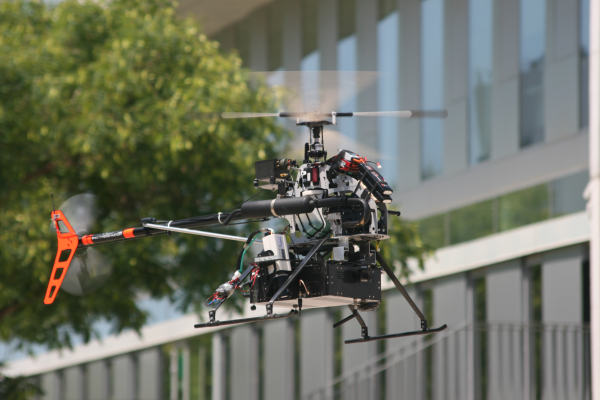Unmanned Aerial Systems
We aim to develop technologies allowing to build low cost UAS and to manage them for a wide range of civil missions while achieving high levels of automation and autonomy.

- Environmental Applications
- Emergency Management
- Communications
- Surveillance and Monitoring
Unmanned Aircraft System Current Research
An Architecture for the Integration of UAS Civil Applications

From the study of UAS civil missions and the state of the art in the design of UAS architecture, an exhaustive list of self-content services needed in almost all UAS civil missions is offered. Thus, the USAL provides a list of common services needed to develop the different civil missions identified. These services have been organized into four different categories, each containing services that cooperate in the same main objective such as Flight, Mission, Payload and Awareness.

Flight Plan and Mission Management
Most current commercial solutions, if not remotely piloted, rely on waypoint based flight control systems for their navigation and are unable to coordinate UAS flight with payload operation. We believe that increased automation, together with reconfiguration capabilities and cost-effectiveness, are key requirements for UAS to be successful in the civil domain. The resulting platform should be affordable and able to operate in different application scenarios with reduced human intervention.

Our group works in the development of a reconfigurable mission management system with the Flight Plan Manager and the Mission Manager at its core. The Flight Plan Manager is responsible for governing the UAS flight, while the Mission Manager orchestrates operation of embarked services. These services operate on top of a commercial off-the-shelf flight control system improving the automation capabilities of the UAS while taking advantage of available technologies.

Reconfiguration is made possible by separating flight and mission execution from its specification. The flight plan and the mission behavior are specified in two separate documents that are respectively submitted to the Flight Plan Manager and the Mission Manager. In this way, these services, act as execution engines able to process and execute the submitted specifications and enable the Unmanned Aircraft System to adapt to a wide range of missions.
Communications Middleware for Embedded Avionics Applications

ICARUS Project: Wildfire Surveillance
The objective of the ICARUS Project is to develop an on-board system for UAV targeted to detection, control and analysis of forest fires. The data processing, acquired in real-time through the UAV, should allow the decision makers to optimize the strategies in the fire mitigation.
The reasons for constructing a system for UAV wildfire surveillance are many. Following we mention some of them:
- Smoke generated by fire covers the forest area and interferes the acquisition of information about the fire evolution.
- The coordinator of the mitigation team must fly over the fire extension, leaving the control centre during a long period of time.
- Nocturnal fly of in presence of dense smoke are extremely dangerous
- Danger can also affect to the firemen on ground because the fast evolution of fire fronts. Today technologies for data acquisition may not be sufficiently fast to take the right decisions on time.
The following components are part of the system:
- On-board UAV Platform
- Flight Control Station
- Processing Station with GIS Capabilities
- Communications Infrastructure
Share: